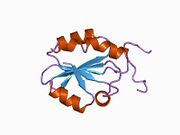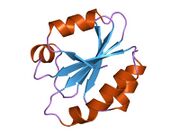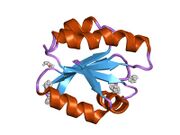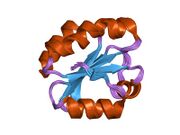Biology:Thioredoxin
 Generic protein structure example |
Thioredoxin (TRX or TXN) is a class of small redox proteins known to be present in all organisms. It plays a role in many important biological processes, including redox signaling. In humans, thioredoxins are encoded by TXN and TXN2 genes.[1][2] Loss-of-function mutation of either of the two human thioredoxin genes is lethal at the four-cell stage of the developing embryo. Although not entirely understood, thioredoxin is linked to medicine through their response to reactive oxygen species (ROS). In plants, thioredoxins regulate a spectrum of critical functions, ranging from photosynthesis to growth, flowering and the development and germination of seeds. Thioredoxins play a role in cell-to-cell communication.[3]
Occurrence
They are found in nearly all known organisms and are essential for life in mammals.[4][5]
Function
The primary function of thioredoxin (Trx) is the reduction of oxidized cysteine residues and the cleavage of disulfide bonds.[6] Multiple in vitro substrates for thioredoxin have been identified, including ribonuclease, choriogonadotropins, coagulation factors, glucocorticoid receptor, and insulin. Reduction of insulin is classically used as an activity test.[7] The thioredoxins are maintained in their reduced state by the flavoenzyme thioredoxin reductase, in a NADPH-dependent reaction.[8] Thioredoxins act as electron donors to peroxidases and ribonucleotide reductase.[9] The related glutaredoxins share many of the functions of thioredoxins, but are reduced by glutathione rather than a specific reductase.
Structure and mechanism
Thioredoxin is a 12-kD oxidoreductase protein. Thioredoxin proteins also have a characteristic tertiary structure termed the thioredoxin fold. The active site contains a dithiols in a CXXC motif. These two cysteines are the key to the ability of thioredoxin to reduce other proteins.
For Trx1, this process begins by attack of Cys32, one of the residues conserved in the thioredoxin CXXC motif, onto the oxidized group of the substrate.[10] Almost immediately after this event Cys35, the other conserved Cys residue in Trx1, forms a disulfide bond with Cys32, thereby transferring 2 electrons to the substrate which is now in its reduced form. Oxidized Trx1 is then reduced by thioredoxin reductase, which in turn is reduced by NADPH as described above.[10]

Trx1 can regulate non-redox post-translational modifications.[11] In the mice with cardiac-specific overexpression of Trx1, the proteomics study found that SET and MYND domain-containing protein 1 (SMYD1), a lysine methyltransferase highly expressed in cardiac and other muscle tissues, is also upregulated. This suggests that Trx1 may also play an role in protein methylation via regulating SMYD1 expression, which is independent of its oxidoreductase activity.[11]
Plants have an unusually complex complement of Trx's composed of six well-defined types (Trxs f, m, x, y, h, and o) that reside in diverse cell compartments and function in an array of processes. Thioredoxin proteins move from cell to cell, representing a novel form of cellular communication in plants.[3]
Interactions
Thioredoxin has been shown to interact with:
- ASK1,[12][13][14]
- Collagen, type I, alpha 1,[15]
- Glucocorticoid receptor,[16]
- SENP1,[17]
- TXNIP.[18]
- NF-κB – by reducing a disulfide bond in NF-κB, Trx1 promotes binding of this transcription factor to DNA.[19]
- AP1 via Ref1 – Trx1 indirectly increases the DNA-binding activity of activator protein 1 (AP1) by reducing the DNA repair enzyme redox factor 1 (Ref-1), which in turn reduces AP1 in an example of a redox regulation cascade.[20]
- AMPK – AMPK function in cardiomyocytes is preserved during oxidative stress due to an interaction between AMPK and Trx1. By forming a disulfide bridge between the two proteins, Trx1 prevents the formation and aggregation of oxidized AMPK, thereby allowing AMPK to function normally and participate in signaling cascades.[21]
Effect on cardiac hypertrophy
Trx1 has been shown to downregulate cardiac hypertrophy, the thickening of the walls of the lower heart chambers, by interactions with several different targets. Trx1 upregulates the transcriptional activity of nuclear respiratory factors 1 and 2 (NRF1 and NRF2) and stimulates the expression of peroxisome proliferator-activated receptor γ coactivator 1-α (PGC-1α).[22][23] Furthermore, Trx1 reduces two cysteine residues in histone deacetylase 4 (HDAC4), which allows HDAC4 to be imported from the cytosol, where the oxidized form resides,[24] into the nucleus.[25] Once in the nucleus, reduced HDAC4 downregulates the activity of transcription factors such as NFAT that mediate cardiac hypertrophy.[10] Trx 1 also controls microRNA levels in the heart and has been found to inhibit cardiac hypertrophy by upregulating miR-98/let-7.[26] Trx1 can regulate the expression level of SMYD1, thus may indirectly modulate protein methylation for purpose of cardiac protection.[11]
Thioredoxin in skin care
Thioredoxin is used in skin care products as an antioxidant in conjunction with glutaredoxin and glutathione.[citation needed]
See also
- RuBisCO - enzyme activity regulated by thioredoxin
- Peroxiredoxin - enzyme activity regulated by thioredoxin
- Thioredoxin fold
- Thioredoxin reductase
References
- ↑ "Cloning and expression of a cDNA for human thioredoxin". The Journal of Biological Chemistry 263 (30): 15506–12. October 1988. doi:10.1016/S0021-9258(19)37617-3. PMID 3170595.
- ↑ "Entrez Gene: TXN2 thioredoxin 2". https://www.ncbi.nlm.nih.gov/gene/25828.
- ↑ 3.0 3.1 "A membrane-associated thioredoxin required for plant growth moves from cell to cell, suggestive of a role in intercellular communication". Proceedings of the National Academy of Sciences of the United States of America 107 (8): 3900–5. February 2010. doi:10.1073/pnas.0913759107. PMID 20133584. Bibcode: 2010PNAS..107.3900M.
- ↑ "Thioredoxin and glutaredoxin systems". The Journal of Biological Chemistry 264 (24): 13963–6. August 1989. doi:10.1016/S0021-9258(18)71625-6. PMID 2668278. http://www.jbc.org/cgi/reprint/264/24/13963.pdf.
- ↑ "Reactive oxygen species, antioxidants, and the mammalian thioredoxin system". Free Radical Biology & Medicine 31 (11): 1287–312. December 2001. doi:10.1016/S0891-5849(01)00724-9. PMID 11728801.
- ↑ "Redox regulation of cellular activation". Annual Review of Immunology 15 (1): 351–69. 1997-01-01. doi:10.1146/annurev.immunol.15.1.351. PMID 9143692.
- ↑ "Entrez Gene: TXN thioredoxin". https://www.ncbi.nlm.nih.gov/sites/entrez?Db=gene&Cmd=ShowDetailView&TermToSearch=7295.
- ↑ "Thioredoxin reductase". The Biochemical Journal 346 (1): 1–8. February 2000. doi:10.1042/0264-6021:3460001. PMID 10657232.
- ↑ "Physiological functions of thioredoxin and thioredoxin reductase". European Journal of Biochemistry 267 (20): 6102–9. October 2000. doi:10.1046/j.1432-1327.2000.01701.x. PMID 11012661.
- ↑ 10.0 10.1 10.2 "Modulation of signaling mechanisms in the heart by thioredoxin 1". Free Radical Biology & Medicine 109: 125–131. December 2016. doi:10.1016/j.freeradbiomed.2016.12.020. PMID 27993729.
- ↑ 11.0 11.1 11.2 "Master redox regulator Trx1 upregulates SMYD1 & modulates lysine methylation". Biochimica et Biophysica Acta (BBA) - Proteins and Proteomics 1854 (12): 1816–1822. December 2015. doi:10.1016/j.bbapap.2015.09.006. PMID 26410624.
- ↑ "Thioredoxin promotes ASK1 ubiquitination and degradation to inhibit ASK1-mediated apoptosis in a redox activity-independent manner". Circulation Research 90 (12): 1259–66. June 2002. doi:10.1161/01.res.0000022160.64355.62. PMID 12089063.
- ↑ "Negative feedback regulation of ASK1 by protein phosphatase 5 (PP5) in response to oxidative stress". The EMBO Journal 20 (21): 6028–36. November 2001. doi:10.1093/emboj/20.21.6028. PMID 11689443.
- ↑ "Mammalian thioredoxin is a direct inhibitor of apoptosis signal-regulating kinase (ASK) 1". The EMBO Journal 17 (9): 2596–606. May 1998. doi:10.1093/emboj/17.9.2596. PMID 9564042.
- ↑ "C-propeptide region of human pro alpha 1 type 1 collagen interacts with thioredoxin". Biochemical and Biophysical Research Communications 295 (3): 663–7. July 2002. doi:10.1016/s0006-291x(02)00727-1. PMID 12099690.
- ↑ "Direct association with thioredoxin allows redox regulation of glucocorticoid receptor function". The Journal of Biological Chemistry 274 (5): 3182–8. January 1999. doi:10.1074/jbc.274.5.3182. PMID 9915858.
- ↑ "SENP1 mediates TNF-induced desumoylation and cytoplasmic translocation of HIPK1 to enhance ASK1-dependent apoptosis". Cell Death and Differentiation 15 (4): 739–50. April 2008. doi:10.1038/sj.cdd.4402303. PMID 18219322.
- ↑ "Identification of thioredoxin-binding protein-2/vitamin D(3) up-regulated protein 1 as a negative regulator of thioredoxin function and expression". The Journal of Biological Chemistry 274 (31): 21645–50. July 1999. doi:10.1074/jbc.274.31.21645. PMID 10419473.
- ↑ "Thioredoxin regulates the DNA binding activity of NF-kappa B by reduction of a disulphide bond involving cysteine 62". Nucleic Acids Research 20 (15): 3821–30. August 1992. doi:10.1093/nar/20.15.3821. PMID 1508666.
- ↑ "AP-1 transcriptional activity is regulated by a direct association between thioredoxin and Ref-1" (in en). Proceedings of the National Academy of Sciences of the United States of America 94 (8): 3633–8. April 1997. doi:10.1073/pnas.94.8.3633. PMID 9108029. Bibcode: 1997PNAS...94.3633H.
- ↑ "A redox-dependent mechanism for regulation of AMPK activation by Thioredoxin1 during energy starvation". Cell Metabolism 19 (2): 232–45. February 2014. doi:10.1016/j.cmet.2013.12.013. PMID 24506865.
- ↑ "Thioredoxin1 upregulates mitochondrial proteins related to oxidative phosphorylation and TCA cycle in the heart". Antioxidants & Redox Signaling 8 (9–10): 1635–50. 2006. doi:10.1089/ars.2006.8.1635. PMID 16987018.
- ↑ "Inhibition of endogenous thioredoxin in the heart increases oxidative stress and cardiac hypertrophy". The Journal of Clinical Investigation 112 (9): 1395–406. November 2003. doi:10.1172/JCI17700. PMID 14597765.
- ↑ "Increased oxidative stress in the nucleus caused by Nox4 mediates oxidation of HDAC4 and cardiac hypertrophy" (in en). Circulation Research 112 (4): 651–63. February 2013. doi:10.1161/CIRCRESAHA.112.279760. PMID 23271793.
- ↑ "A redox-dependent pathway for regulating class II HDACs and cardiac hypertrophy". Cell 133 (6): 978–93. June 2008. doi:10.1016/j.cell.2008.04.041. PMID 18555775.
- ↑ "Thioredoxin 1 negatively regulates angiotensin II-induced cardiac hypertrophy through upregulation of miR-98/let-7" (in en). Circulation Research 108 (3): 305–13. February 2011. doi:10.1161/CIRCRESAHA.110.228437. PMID 21183740.
Further reading
- "Physiological functions of thioredoxin and thioredoxin reductase". European Journal of Biochemistry 267 (20): 6102–9. October 2000. doi:10.1046/j.1432-1327.2000.01701.x. PMID 11012661.
- "Regulatory roles of thioredoxin in oxidative stress-induced cellular responses". Redox Report 6 (5): 289–95. 2002. doi:10.1179/135100001101536427. PMID 11778846.
- "Thioredoxin and ventricular remodeling". Journal of Molecular and Cellular Cardiology 41 (5): 762–73. November 2006. doi:10.1016/j.yjmcc.2006.08.006. PMID 17007870.
- "Isolation and characterization of human thioredoxin-encoding genes". Gene 102 (2): 221–8. June 1991. doi:10.1016/0378-1119(91)90081-L. PMID 1874447.
- "Identification of a thioredoxin-related protein associated with plasma membranes". Biochemical and Biophysical Research Communications 175 (1): 123–8. February 1991. doi:10.1016/S0006-291X(05)81209-4. PMID 1998498.
- "High-resolution three-dimensional structure of reduced recombinant human thioredoxin in solution". Biochemistry 30 (10): 2685–98. March 1991. doi:10.1021/bi00224a017. PMID 2001356.
- "Human thioredoxin reactivity-structure/function relationship". Biochemical and Biophysical Research Communications 173 (3): 1375–81. December 1990. doi:10.1016/S0006-291X(05)80940-4. PMID 2176490.
- "A proton nuclear magnetic resonance assignment and secondary structure determination of recombinant human thioredoxin". Biochemistry 28 (17): 7088–97. August 1989. doi:10.1021/bi00443a045. PMID 2684271.
- "ATL-derived factor (ADF), an IL-2 receptor/Tac inducer homologous to thioredoxin; possible involvement of dithiol-reduction in the IL-2 receptor induction". The EMBO Journal 8 (3): 757–64. March 1989. doi:10.1002/j.1460-2075.1989.tb03436.x. PMID 2785919.
- "Cloning and expression of a cDNA for human thioredoxin". The Journal of Biological Chemistry 263 (30): 15506–12. October 1988. doi:10.1016/S0021-9258(19)37617-3. PMID 3170595.
- "Thioredoxin, a mediator of growth inhibition, maps to 9q31". Genomics 26 (2): 379–81. March 1995. doi:10.1016/0888-7543(95)80223-9. PMID 7601465.
- "Solution structure of human thioredoxin in a mixed disulfide intermediate complex with its target peptide from the transcription factor NF kappa B". Structure 3 (3): 289–97. March 1995. doi:10.1016/S0969-2126(01)00159-9. PMID 7788295.
- "Construction of a human full-length cDNA bank". Gene 150 (2): 243–50. December 1994. doi:10.1016/0378-1119(94)90433-2. PMID 7821789.
- "The high-resolution three-dimensional solution structures of the oxidized and reduced states of human thioredoxin". Structure 2 (6): 503–22. June 1994. doi:10.1016/S0969-2126(00)00051-4. PMID 7922028.
- "The predicted amino acid sequence of human thioredoxin is identical to that of the autocrine growth factor human adult T-cell derived factor (ADF): thioredoxin mRNA is elevated in some human tumors". Biochimica et Biophysica Acta (BBA) - Gene Structure and Expression 1218 (3): 292–6. August 1994. doi:10.1016/0167-4781(94)90180-5. PMID 8049254.
- "The solution structure of human thioredoxin complexed with its target from Ref-1 reveals peptide chain reversal". Structure 4 (5): 613–20. May 1996. doi:10.1016/S0969-2126(96)00065-2. PMID 8736558.
- "Crystal structures of reduced, oxidized, and mutated human thioredoxins: evidence for a regulatory homodimer". Structure 4 (6): 735–51. June 1996. doi:10.1016/S0969-2126(96)00079-2. PMID 8805557.
- "Human thioredoxin homodimers: regulation by pH, role of aspartate 60, and crystal structure of the aspartate 60 --> asparagine mutant". Biochemistry 36 (46): 13979–88. November 1997. doi:10.1021/bi971004s. PMID 9369469.
- "Thioredoxin expression in the human endometrium during the menstrual cycle". Molecular Human Reproduction 3 (11): 989–93. November 1997. doi:10.1093/molehr/3.11.989. PMID 9433926.
- "The expression of thioredoxin mRNA is increased in the human cervix during pregnancy". Molecular Human Reproduction 3 (12): 1113–7. December 1997. doi:10.1093/molehr/3.12.1113. PMID 9464857.
- "Structural basis for target protein recognition by the protein disulfide reductase thioredoxin". Structure 14 (11): 1701–10. November 2006. doi:10.1016/j.str.2006.09.012. PMID 17098195.
External links
- Thioredoxin at the US National Library of Medicine Medical Subject Headings (MeSH)
- Overview of all the structural information available in the PDB for UniProt: P10599 (Thioredoxin) at the PDBe-KB.
 |






















